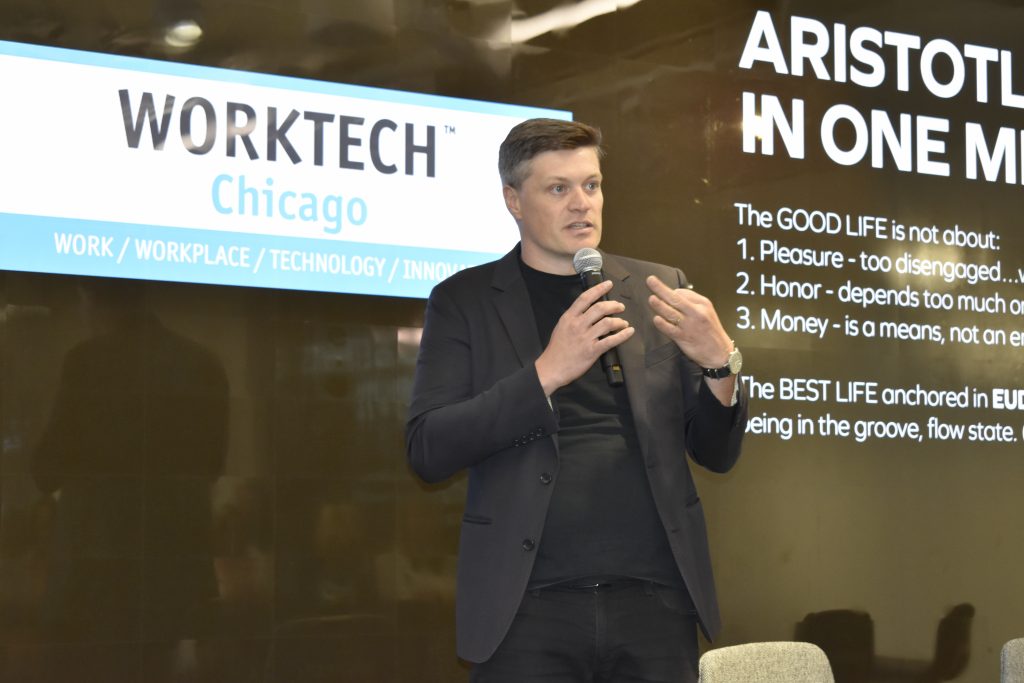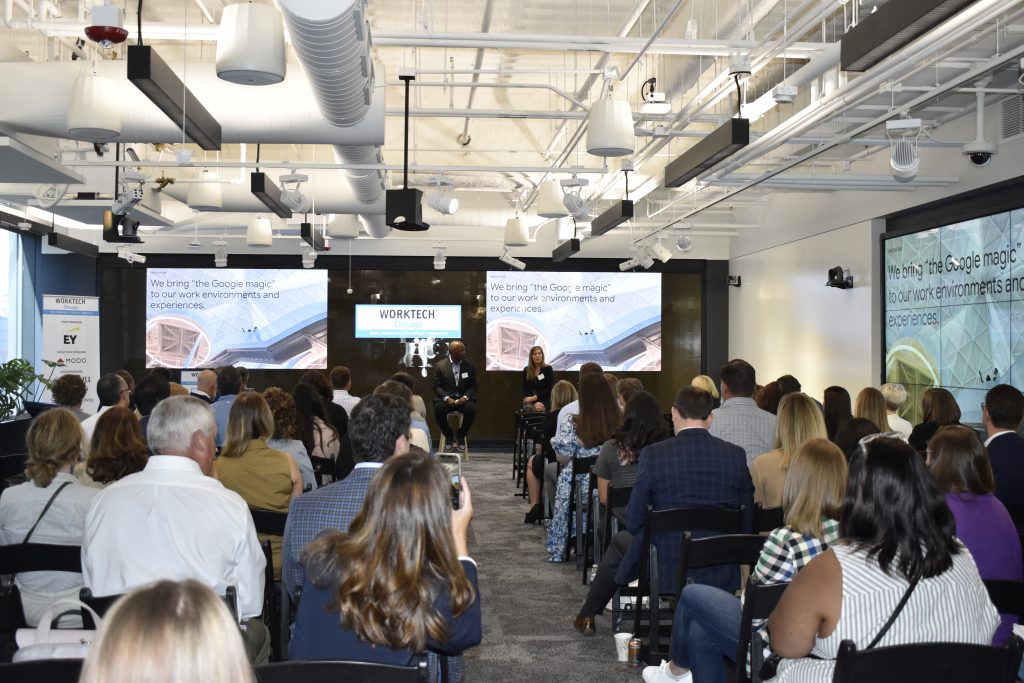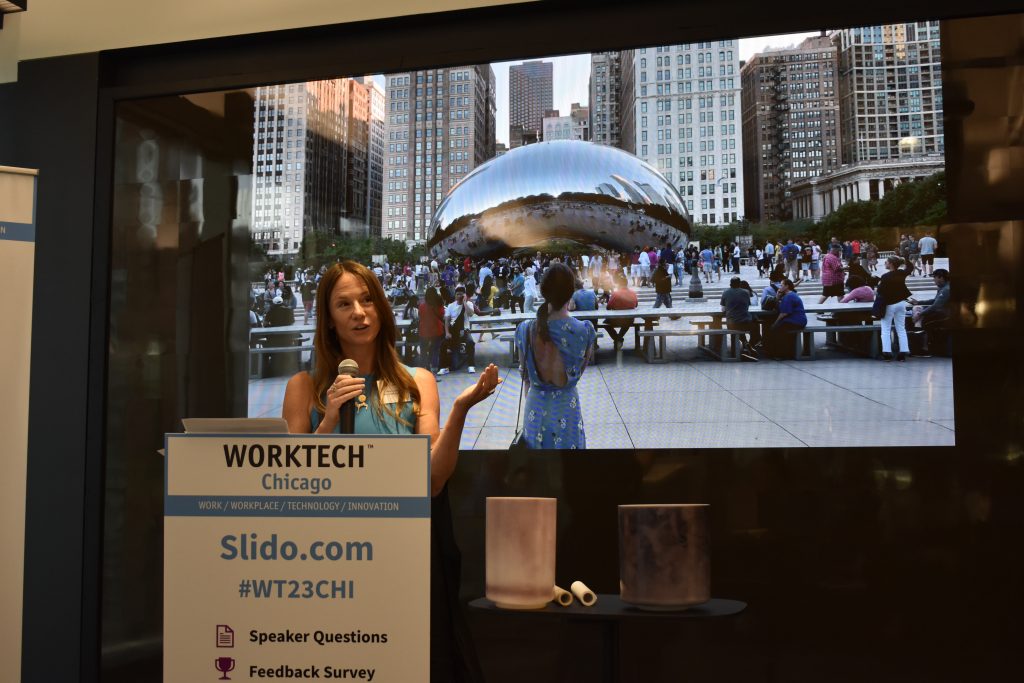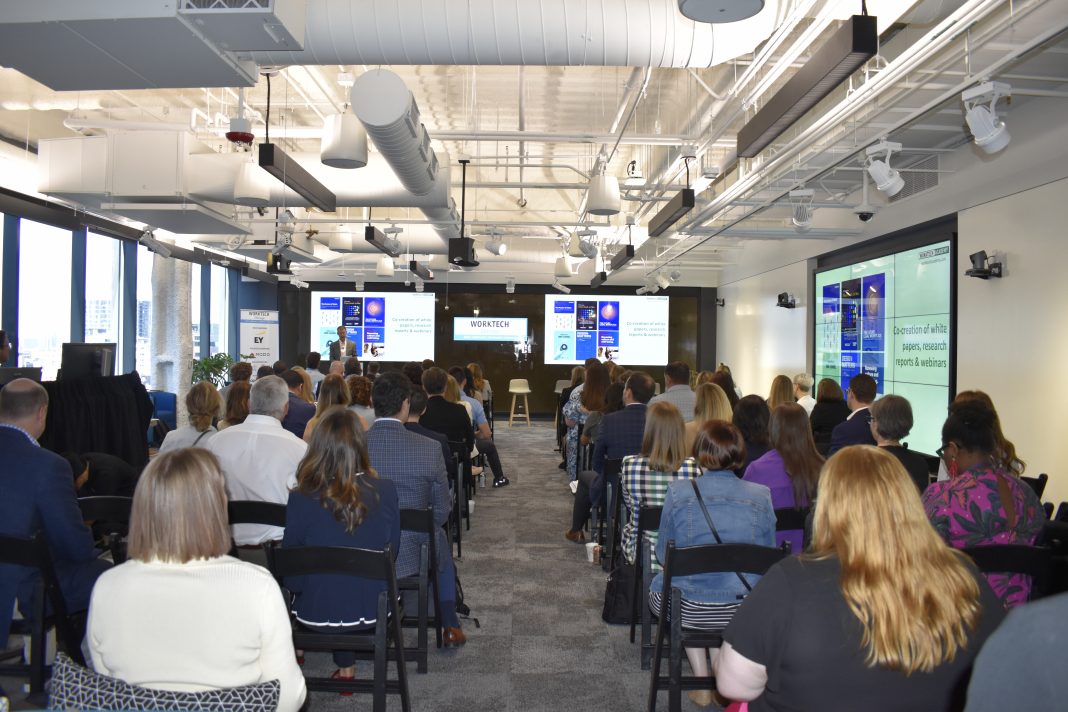Ware Malcomb’s Cynthia Milota and Work Design’s Michelle Weiss share the 4 key themes from the WORKTECH Conference in Chicago in July 2023.
WORKTECH, the global workplace conference brings together interdisciplinary speakers and learning experiences to enhance creativity and forward thinking. Convened in Chicago, over 100 attendees representing tech incubators through Chicago’s largest employers gathered at EY’s wavespace™ in Fulton Market to share stories and strategies for maximizing the workplace experience.
Speakers and panelists included: Mitchell Bobman/Northern Trust; DeJeana Chappell/EY; David Dewane/geniant; Julia Hayes/Mondelez; Molly Laurain/Salesforce; Corey Lewis/Google; Jeffrey Martin/Wells Fargo; Kelly Robinson/Kelly Robinson Designs and more. They described the balance between friction points and incentives, emphasizing the importance of the office, still, in the ecosystem of work.
Four themes that resonated through out the day are curated here: People: Employee Experience • Place: Advantage • Pilots: Testing Ideas • and Pivot: Enhancing success.

People: Employee Experience
Presence is not experience.
– Mitchell Bobman, Vice President, Workplace Technology at Northern Trust
Organizational mandates have returned many employees to the office. However, presence and physical occupancy do not equal productivity. Exploring what employees do while in the office or what attracts them to come in on certain days, provides qualitative insights into the quantitative measure of badge and utilization data. Panelists reported that cultural events, special food opportunities, limited time only activities and even leadership being present and visible, contributed to upticks in employee attendance and engagement.
Employee experience is driven by the value of in-person cross functional partnerships. The people equation of the workplace was categorized by one panelist into four groups:
- Teams who thing of things
- Teams who build things
- Teams who sell things
- Teams that support and enable all these types of work
Panelists universally confirmed that the office is not just for collaboration, but a balance of all four forms of work (collaborating, focusing, socializing, and learning). One organization’s data found that 84% of their employees come into the office to do heads down focus work. Understanding what employees need to “keep the magic fluid,” and how the workplace can be supportive was the daily objective of the speakers and audience members.
Place: Advantage
Enviable workspaces provide creature comforts, but admirable workspaces have soul.
– David Dewane, Chief Experience Officer, Physical Space at geniant
The keynote speaker presented the concept of eudaemonia, from Aristotle, a deep state of flourishing, wellbeing, and happiness. Enviable workspaces are open, bathed in daylight, amenity filled and reflect the mission and values of the organization. Admirable workspaces on the other hand, may have originally been temporary or re-purposed, think the founder’s garage (the birth of Apple) or a space beneath a football field (The Manhattan Project: laboratory under Stagg Field) with their legendary status as the place where historic things happened. Whether enviable or admirable, high performance offices offer not only mission driven collaboration spaces, but also opportunities for distraction free deep work.
Like the EY wavespace, created for client journeys, the best of today’s offices provides places and incentives to use and experience all the spaces in the office.

Pilots: Testing Ideas
There’s no average user, we watch people and optimize the space use over time.
– David Dewane, Chief Experience Officer, Physical Space at geniant
Defining and measuring success, panelists delved into their data gathering methods and how they influenced planning and operations. Performance metrics were established at the beginning of a project and those criteria evolved as the project unfolded.
- Sensor and heat maps, measured macro and micro space utilization.
- Cameras in video conferencing equipment released a room reservation if not occupied after 7 minutes.
- Counting reconfigurations of mobile furniture, informed product types and usage.
- Observations by facilities and hospitality teams monitored the happenings in the neighborhoods, especially on anchor days when more staff are in the office.
- Focus groups assessed breakfast and lunch options around the office and surrounding locale.
Panelists confirmed that they all have engagement statistics from EOS (employee opinion surveys), access data from badge swipes, numbers of emails being sent, and the amount of meetings being scheduled, but this quantitative information often presents confounding variables. Single data points like survey responses might be mis-leading or outdated. Qualitative data points like observations and focus were characterized as “front of house” and quantitative data such as badge swipes, IP address connections and reservation data were considered “back of house.” Organizations must identify what they are solving for and have specific criteria for gathering, using, and testing information.
Pivot: Enhancing Success
It’s okay to stop and re-start, fail fast, and experiment.
– Corey Lewis, Senior Director of Workplace Services, Americas at Google
Often, a space or policy or mandate may not be working out as intended or delivering the desired impact. All panelists discussed the disconnect between leadership and employees regarding working in the office. Strategies for limiting this friction, such as change management and providing a seamless plug and play environment were deemed essential. There is also the ever present, often un-spoken, option to add capacity or reduce footprint. Panelists suggested now more than ever, their organizations were game to try things, re-assess and move in an alternate direction. A cohort of cross functional partners “air out” the failings, opportunities, and options. All agreed that this method does take more
time but will ultimately deliver the best employee experience while optimizing the portfolio.

Measure twice…or more. Be prepared to re-cut.
If we could remove the commute factor, what other barriers are preventing employees from wanting to work in the office.
– Brian McCourt, Smart Building Consultant, Cisco
Business metrics to inform the pivot include feedback, utilization data, and escalation. Employees no longer show up and just sit at their desks. Their work in teams, with employees not physically present and doing focus work demands a complex workplace ecosystem to support the individual, team, and organization. Companies do much to enhance their products, brands, and local office culture; often celebrating community and diversity. Calculating and curating every step of the employee workplace journey is the goal. As one real estate industry partner concluded, data is not that hard to get, but ensuring its reliability, making it useable and actionable, that’s the big opportunity.
We hope you’ll join us for more WORKTECH in 2023.
Photos courtesy of WORKTECH


